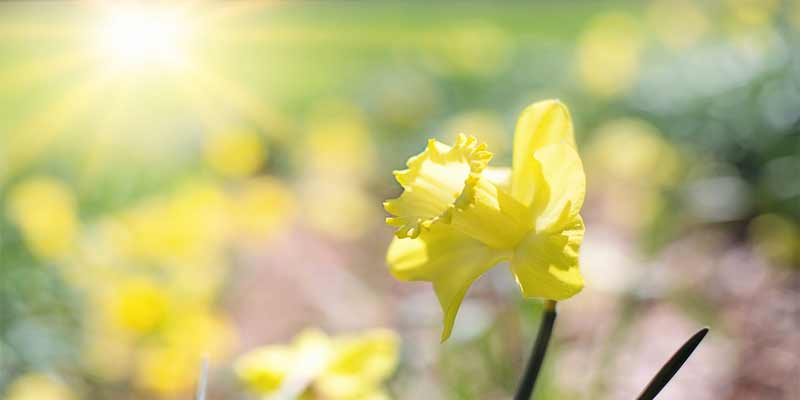Sunny blooms and captivating charm: daffodils epitomize the advent of spring. These resilient flowers infuse gardens, parks, and landscapes worldwide with a burst of color; however, to thrive and flourish, they demand more than mere soil and water—they necessitate an optimal dosage of sunlight.
This comprehensive guide delves into the sunlight requirements of daffodils, providing illuminating insights on their optimal sun exposure for thriving and blooming with vibrancy.
The Sunlight Preferences of Daffodils
Scientifically known as Narcissus, Daffodils revel in bright, well-lit conditions as sun-loving plants. Several aspects of their growth and development including photosynthesis, flower production, and overall plant vigor depend on adequate sunlight.
Therefore understanding daffodils’ preferences for sunlight becomes crucial to selecting suitable planting locations thereby optimizing their performance in the garden.
Optimal Sunlight Conditions
Daffodils generally thrive in full to partial sunlight. They require a minimum of six hours of direct exposure per day. The term “full sunlight” denotes areas that bask primarily—indeed unobstructed—in sun rays; typically, these are spaces facing south or west and therefore experiencing the most intense radiation throughout daylight hours.
Conversely–”partial sunlight”—refers to locales receiving either filtered light or dappled shade over their entirety; examples include spots beneath the leafy canopy of deciduous trees or proximate structures yielding shadowy coverings.
Daffodils in cooler climate regions, or those exposed to intense summer heat, might benefit from partial shade during peak temperatures; this strategy aids in preventing stress and sunburn.
It remains crucial nonetheless: a balance between sunlight and shade must be struck – excessive shading can result not only in diminished flower production but also elongated weak stems.
The Role of Sunlight in Daffodil Growth
Sunlight plays a crucial role in various aspects of daffodil growth and development:
1. Photosynthesis
Sunlight furnishes the indispensable energy for photosynthesis, a process where plants transform light energy into chemical fuel, thereby generating carbohydrates and oxygen.
The utilization of sunlight by daffodil leaves allows them to manufacture food; this fuels their growth while bolstering overall plant health.
2. Flower Production
Adequate sunlight stimulates the formation and development of flower buds in daffodils for flower production. The timing and intensity of flowering also vary with sunlight exposure; well-lit plants produce more robust blooms, initiating their blossoming earlier in the season.
3. Plant Vigor
Sunny locations bolster the vigor of daffodils, manifesting in robust stems, luscious foliage, and abundant flowering. The exposure to sunlight not only fortifies their growth but also augments their resilience against environmental stressors like wind and inclement weather.
3 Factors Influencing Sunlight Availability
The availability of sunlight in the garden, as well as daffodil growth, can be influenced by several factors:
1. Seasonal Variation
Sunlight intensity and duration vary seasonally as the Earth’s orientation to the sun changes: during spring months, when daylight hours lengthen and the angle of incidence from the sun to Earth increases, daffodils consequently receive ample sunlight.
2. Obstructions
Obstructions such as buildings, trees, fences, and structures limit sunlight penetration in specific garden areas by casting shadows. When you choose planting sites for daffodils, factor in these potential obstacles; opt for locations that receive ample daylight throughout the day.
3. Orientation
Planting beds and garden borders’ orientation influences sunlight exposure. South-facing areas attract more sunlight than their north-facing counterparts; east and west-facing locations.
On the other hand, capture morning east, and afternoon west sunlight respectively.
Tips for Providing Adequate Sunlight
Consider the following tips to ensure daffodils thrive by receiving ample sunlight:
Selection of Site
Opt for planting locations that bask in an abundance of sunlight, particularly from early to mid-morning when the intensity is at its peak.
Refrain from choosing shaded areas or dense tree canopies, which are places where daffodils should not be planted due to limited exposure to sunlight.
Clear Obstructions
Trim back overhanging branches, remove debris, and eliminate obstructions blocking sunlight from reaching daffodil beds to clear any potential issues.
By pruning trees and shrubs for improved light penetration; you can create a sunnier environment conducive for the growth of daffodils.
Monitor Sunlight Exposure
Throughout the day, observe the sunlight patterns in your garden; assess varying degrees of exposure to sunlight across different areas.
Track seasonal changes in this exposure meticulously, and adjust planting locations accordingly to guarantee optimal growing conditions for daffodils.
Conclusion
Bright, sunny conditions fuel the thriving of daffodils; abundant flowering and healthy growth require sufficient sunlight. Comprehending their preferences for sunlight, and then providing optimal growing conditions. This is your key to cultivating a stunning display of daffodil blooms that herald spring’s arrival.
Be it in garden borders or meadows naturalized with these charming flowers; among perennials, they are nestled, daffodils bring joy and beauty to outdoor spaces through their radiant charm and enduring appeal. Embrace the enchantment of springtime; celebrate in your garden landscape, acknowledging daffodils’ affinity for sunshine.



Leave a Reply